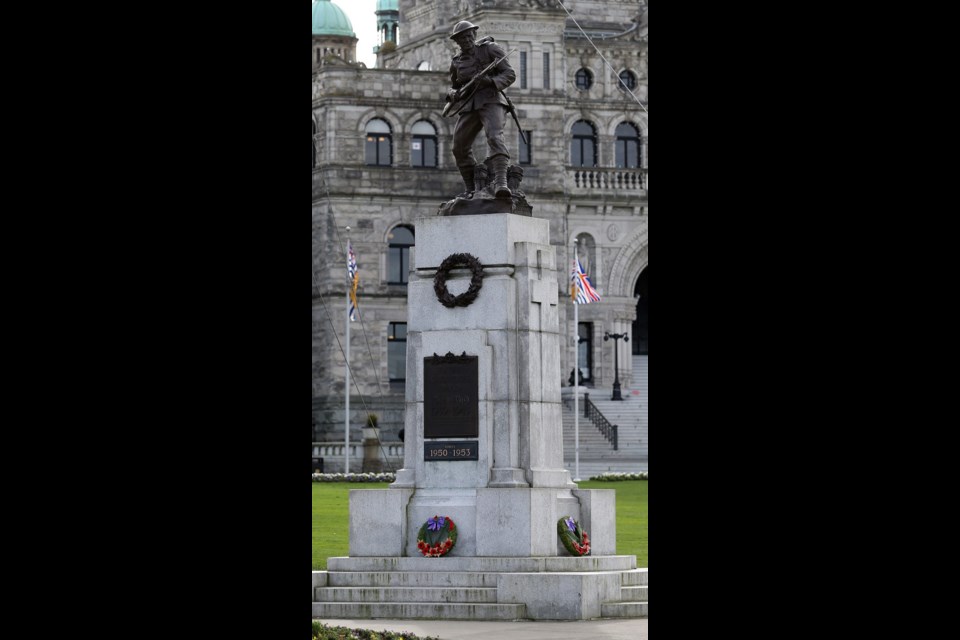Remembered in Bronze and Stone
By Alan Livingstone MacLeod
Heritage, 192 pp., $24.95
��
On Sunday, July 12, 1925, an estimated 3,000 people gathered at Parliament Square to witness the unveiling of Victoria’s war memorial, the monument to the fallen soldiers of the First World War.
The Daily Colonist said the ceremony took place “under a solemn sky, veiled with portentous clouds — a typical Flanders sky.” This was a reference to the area in Belgium where so many Canadians gave their lives.
“Those who saw the ceremony will not soon forget it,” the Colonist said. “The scene was impressive. In the background rose the stately grey pile of the Parliament buildings.
“Massed under the leafy trees and among the clusters of vivid flowers on the spacious green lawns were crowds of people. Further thousands packed the four streets meeting at the corner where the memorial stands.”
The ceremony was led by Lt.-Gov. Walter Cameron Nichol. Among the dignitaries who attended were Col. Cy Peck, a winner of the Victoria Cross; Sydney March, the sculptor responsible for the monument; his brother Vernon, who was also a sculptor; and lawyer Lindley Crease, who had been the chairman of the war memorial committee.
That committee was crucial to the creation of Victoria’s war memorial, since it was not a government initiative. It was built by public subscription, with fundraising started in September 1924.
Frederick Bernard Pemberton played a key role in organizing the committee, coming up with a design for the memorial and seeing it built. He enlisted his friend, Lindley Crease, to lead the fundraising drive.
Nichol, the lieutenant-governor, gave the campaign a healthy start when he contributed $5,000. He gave another $500 at the end, to help carry the campaign over its goal. The second-largest donation came from the Union Club, which contributed $771 on behalf of its members.
The memorial cost $13,000, at a time when a nice home might go for $2,500. The base alone, built by John Mortimer and Son, was worth $5,650.
The Victoria memorial is one of those featured in Alan Livingstone MacLeod’s marvelous new book, Remembered in Bronze and Stone. It is a celebration of monuments found across sa���ʴ�ý, complete with colour photographs and stories.
Those stories touch on many different aspects, including the history of the memorials included, information on the communities then and now, and some of the people who went from those communities to fight in the Great War.
The result is a tourist guide of sorts — a journey across sa���ʴ�ý, with stops at war memorials, and with enough good information to make the reader want to do the same tour — or at least, check out the memorials close to home.
MacLeod notes the similarities between memorials in different communities; in some cases, the same designs were shared. More importantly, he also deals with the poor condition he found when he visited some of the memorials.
The book becomes, to a certain extent, a call for the preservation of these memorials. All of the soldiers who fought in the Great War have gone, and Second World War veterans are also fading away. It is important for us to remember what they did for their country, and for us.
There is a good chance that Remembered in Bronze and Stone would not have been written without the inspiration provided by people in Victoria, most notably Sidney Allinson. At a meeting of the Pacific Coast branch of the Western Front Association, Allinson insisted that MacLeod’s work on memorials needed to be in a book.
MacLeod lives in Victoria. He credits four others from here, all members of the association — John Azar, Mary Sanseverino, Wayne Ralph and Barry Gough — for helping to get the project moving.
All of these people did a service to all of us. After a century, it is hard to find something new to write about the First World War, but this book takes an important step forward.
The Victoria memorial has been an important monument adjacent to the Inner Harbour for more than 90 years. It is a place for the community to remember, and for younger people to start to understand the sacrifices made by their ancestors.
Our memorial also has a strong connection with a more prominent one. After Vernon March watched the unveiling of his brother Sydney’s work, he won the contract for the National War Memorial in Ottawa.
Vernon March did not live to see the completion of the national monument in 1932, but his efforts on behalf of the nation are appreciated every day, in every year.
The reviewer is the editor-in-chief of the sa���ʴ�ý.



